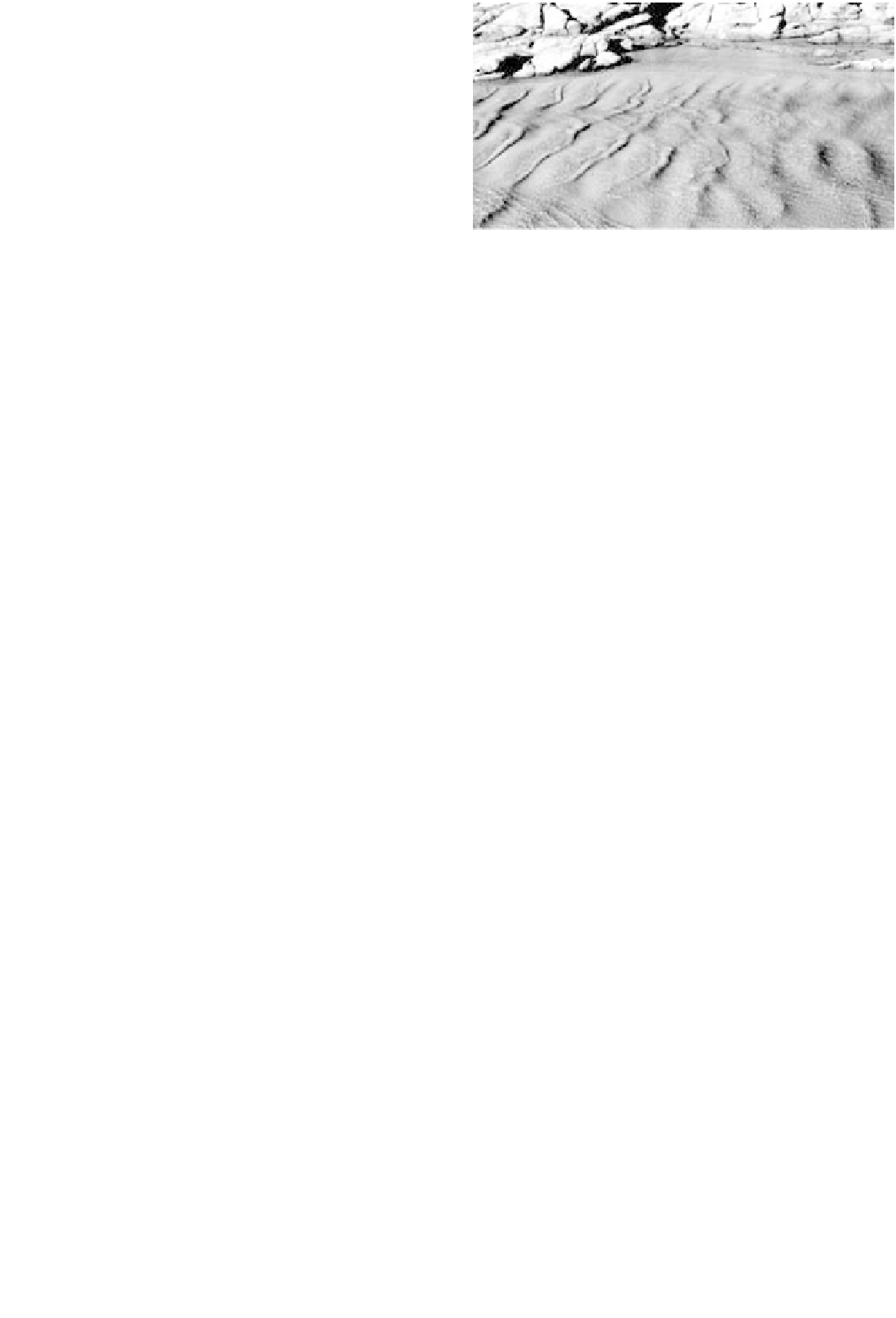Geoscience Reference
In-Depth Information
enlarged by flow separation processes. Ripples do not form
in coarse sands (
d
0.7 mm); instead a
lower-stage plane
bed
is the stable form. The transition coincides with disrup-
tion of the viscous sublayer by grain roughness and the
enhancement of vertical turbulent velocity fluctuations. The
effect of enhanced mixing is to steepen the velocity gradient
and decrease the pressure rise at the bed in the lee of defects
so that the defects are unable to amplify to form ripples.
With increasing flow strength over sands and gravels, cur-
rent ripples and lower-stage plane beds give way to
dunes
.
These large bedforms (Fig. 4.40a, b) are similar to current
ripples in general shape but are morphologically distinct,
with dune size related to flow depth. The flow pattern over
dunes is similar to that over ripples, with well-developed
flow separation and reattachment. In addition, large-scale
advected eddy motions rich in suspended sediment are gen-
erated along the free-shear layer of the separated flow. The
positive relationship between dune height, wavelengths, and
flow depth indicates that the magnitude of dunes is related
to thickness of the boundary layer or flow depth.
As flow strength is increased further over fine to coarse
sands, intense sediment transport occurs as small-amplitude/
long wavelength bedwaves migrate over an
upper-stage
plane bed
.
Antidunes
are sinusoidal forms with accompanying in
phase water waves (Fig. 4.41) that periodically break and
(a)
(b)
Fig. 4.41
Fast, shallow water flow (flow right to left; Froude number
0.8) over sand to show downstream trend from (a) in-phase
standing waves over antidune bedforms, to (b) downstream to
upstream-breaking waves. In the next few seconds the breaking
waves propagate into area (a). The standing waves subsequently
reform over the whole field and thereafter the upstream-breaking
cycle begins again.
move upstream, temporarily washing out the antidunes.
They occur as stable forms when the flow Froude number
(ratio between velocity of mean flow and of a shallow
water wave, that is,
u
/(
g
d
)
0.5
) is
0.84, approximately
indicative of rapid (supercritical) flow, and are thus com-
mon in fast, shallow flows. Antidune wavelength is related
to the square of mean flow velocity.
4.9
Waves and liquids
Waves are periodic phenomena of extraordinarily diverse
origins. Thus we postulate the existence of sound and elec-
tromagnetic waves, and directly observe waves of mass
concentration each time we enter and leave a stationary or
slowly moving traffic jam. A great range of waveforms
transfer energy in both the atmosphere and oceans, with
periods ranging from 10
2
to 10
5
s for ocean waves. They
transfer energy and, sometimes, mass. The commonest vis-
ible signs of fluid wave motion are the surface waveforms
of lakes and seas. Many waveforms are in lateral motion,
traveling from here to there as
progressive waves
, although
some are of too low frequency to observe directly, like the
tide. Yet others are
standing waves
, manifest in many
coastal inlets and estuaries. In the oceans, waves are usually
superimposed on a flowing tidal or storm current of
greater or lesser strength. Such
combined flows
carry attrib-
utes of both wave and current but the combination is more
complex than just a simple addition of effects (Section 4.10).
Waves also occur at density interfaces within
stratified
fluids
as
internal waves
, as in the motion along the
oceanic, thermocline, oceanic, and shelf margin tides,
density and turbidity currents. We must also note the
astonishing
solitary waves
seen as tidal bores and reflected
density currents.
4.9.1
Deep water, surface gravity waves
“Deep” in this context is a
relative
term and is formally
defined as applying when water depth,
h
, is greater than a
half wavelength, that is,
h
/2 (Fig. 4.42). Deep water
waves at the sea or lake surface are more-or-less regular
periodic disturbances created by surface shear due to
blowing wind. The stationary observer, fixing their gaze at
a particular point such as a partially submerged marker
post, will see the water surface rise and fall up the post as a
wave passes by through one whole wavelength. This rise
and fall signifies the conversion of wave potential to kinetic
energy. The overall wave shape follows a curve-like, sinu-
soidal form and we use this smoothly varying property as a



Search WWH ::

Custom Search